
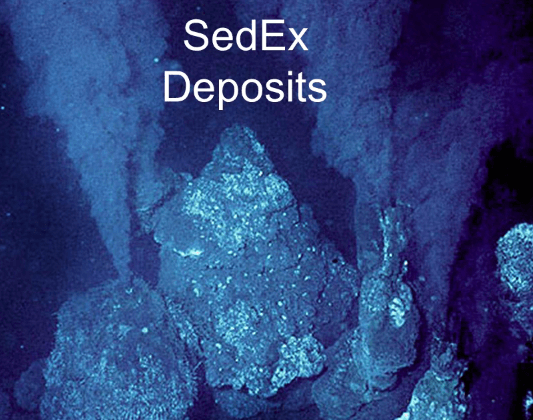
Another submarine syngeneic sulphide deposits- the SEDimentary exhalative or SEDEX deposit. These are very familiar in genesis to the VMS deposits except they are not primarily driven by intrusions below but are instead products of dewatering and metamorphism of thick piles of accumulated sediments in ocean basins hence the “SED” part of the name, the “exhalative” portion of the name refers to the geological process of venting hydrothermal solutions into submarine environment. Here’s a list of some well-known SEDEX submarine deposits you may have heard of including, Sullivan of British Columbia and Broken Hill in Australia. 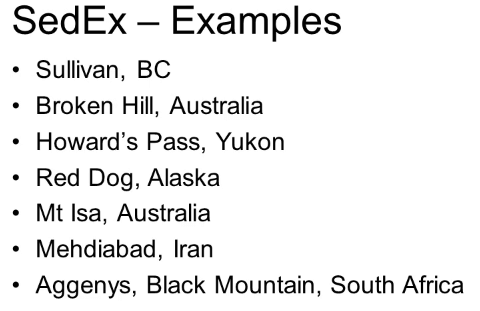 I’ll talk about Sullivan in a little more detail in a few minutes time.
I’ll talk about Sullivan in a little more detail in a few minutes time.
What are the similarities and differences between SEDEX deposits and VMS deposits?
Let’s start with the similarities, both are syngeneic, that is they drop deposit at the same time as hosting rocks. Again the majority of metal in SEDEX deposits is in the form of bedded exhalative massive sulphides, with an underlying feeder zone, they too often occur in clusters. In both deposit types the metal is carried the solution as chloride complexes rather than fire complexes, so the main trigger for precipitation, as i mentioned earlier, is a drop in temperature. Lastly the massive sulphide lenses are usually highly deformed.
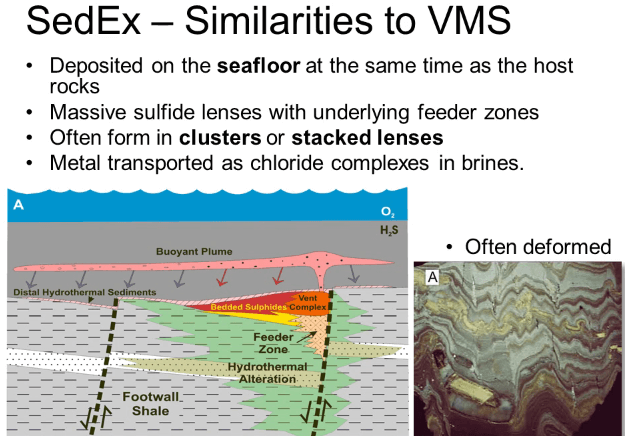 But now the differences, firstly, SEDEX deposits are generally formed in fault-bounded sedimentary basins on continental crust rather than in volcanic piles on oceanic crust.
But now the differences, firstly, SEDEX deposits are generally formed in fault-bounded sedimentary basins on continental crust rather than in volcanic piles on oceanic crust.  For SEDEX deposits, the basin needs to accumulate several kilometres or tens of kilometres of oxygen lacking sediment, usually shells. Secondly, the heat that drives the hydrothermal system is dominantly from depth and burial rather than a felsic intrusion although there may be a deep mafic intrusion. For the same reason the metals are not derived from felsic magmas, so copper is largely missing, instead the metals are purely derived from leaching of the sediments themselves and lead, zinc and silver dominate instead.
For SEDEX deposits, the basin needs to accumulate several kilometres or tens of kilometres of oxygen lacking sediment, usually shells. Secondly, the heat that drives the hydrothermal system is dominantly from depth and burial rather than a felsic intrusion although there may be a deep mafic intrusion. For the same reason the metals are not derived from felsic magmas, so copper is largely missing, instead the metals are purely derived from leaching of the sediments themselves and lead, zinc and silver dominate instead.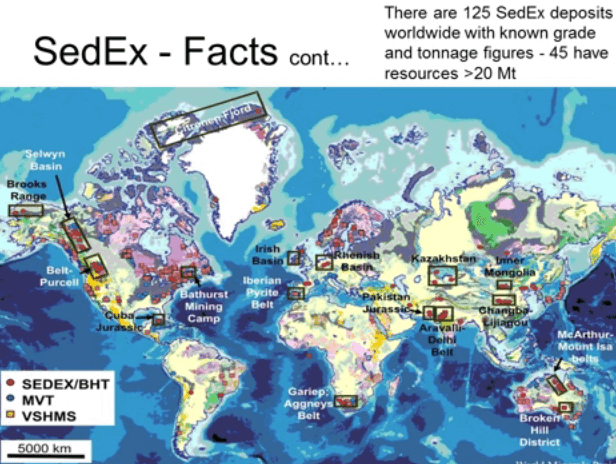
To form SEDEX deposits, you require the deep sedimentary basins so distribution is more limited than that of VMS deposits, however they are still found on all continents and there are about 125 SEDEX deposits on note, and these are marked in red on the map. They vary considerably in both size and grade. 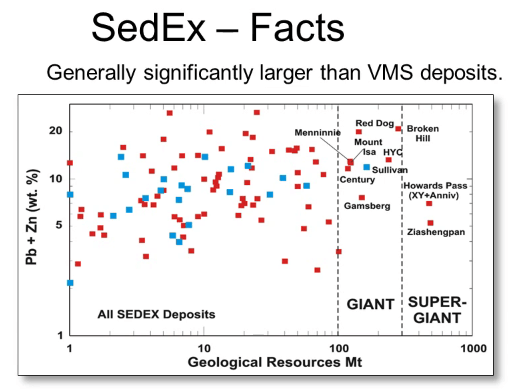 This graph shows that range, tonnes per percent metal. Size along the x-axis varies from 1 million tonnes up to a huge 400 million tonnes with the mean standing around about 20 million tonnes. Lead and zinc grades, that’s the y- axis, ranges from 3% up to 30 %, with a mean of about 10-12%. As you can see, SEDEX deposits are both much bigger than VMS deposits and have better grades, making them highly desirable exploration target.
This graph shows that range, tonnes per percent metal. Size along the x-axis varies from 1 million tonnes up to a huge 400 million tonnes with the mean standing around about 20 million tonnes. Lead and zinc grades, that’s the y- axis, ranges from 3% up to 30 %, with a mean of about 10-12%. As you can see, SEDEX deposits are both much bigger than VMS deposits and have better grades, making them highly desirable exploration target.
Problem of course is that they are much less common. In spite of their scarcity, they are a large source of the world’s lead and zinc SEDEX deposits range in age from the mid-Proterozoic that is 180 million years ago to the Phanerozoic, 150 million years ago. The Sullivan in Southeast British Columbia is 150 million tonnes making it a larger than average SEDEX deposit, but the grades are pretty much average with about 11% combined of lead and zinc.
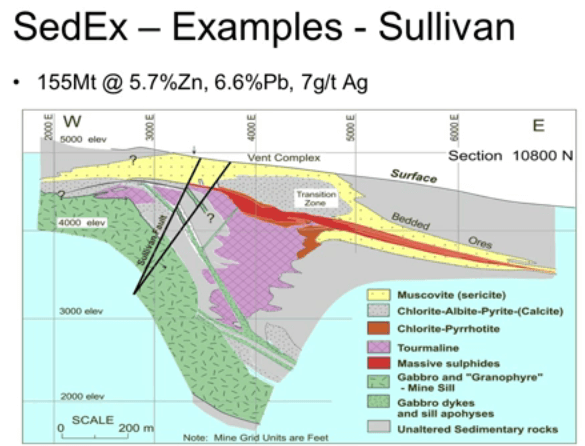 This is a cross section through the Sullivan deposit, it displays of the typical characteristics of SEDEX deposits. You can see the massive lead and zinc sulphides in red, the deposit is underlain by sill that may be partially responsible for driving the hydrothermal system. Shells contain the high highest amount of boron of any rock type and this is leached out along with the lead and zinc, by dewatering fluids, it is then deposited just below the vent as a stock work of tourmaline rich veins. The fault sinapters are occurring to the west of the vent- i suspect that the vent is self is actually developed along the main structure although it’s no longer recognized as a fault due to the breatiation. The rock could maybe reach a foot in the massive sulphide and above the vent chemically altered i.e. quartz, sericite, pyrite alteration. The important thing to realize is that depositing massive sulphides is a slow process, there needs to be a break in sedimentation to allow the sulphides to accumulate, undiluted, by deposited sediment. Recognizing those time breaks in sedimentation, can form exploration target for both SEDEX deposits and VMS deposits.
This is a cross section through the Sullivan deposit, it displays of the typical characteristics of SEDEX deposits. You can see the massive lead and zinc sulphides in red, the deposit is underlain by sill that may be partially responsible for driving the hydrothermal system. Shells contain the high highest amount of boron of any rock type and this is leached out along with the lead and zinc, by dewatering fluids, it is then deposited just below the vent as a stock work of tourmaline rich veins. The fault sinapters are occurring to the west of the vent- i suspect that the vent is self is actually developed along the main structure although it’s no longer recognized as a fault due to the breatiation. The rock could maybe reach a foot in the massive sulphide and above the vent chemically altered i.e. quartz, sericite, pyrite alteration. The important thing to realize is that depositing massive sulphides is a slow process, there needs to be a break in sedimentation to allow the sulphides to accumulate, undiluted, by deposited sediment. Recognizing those time breaks in sedimentation, can form exploration target for both SEDEX deposits and VMS deposits.
